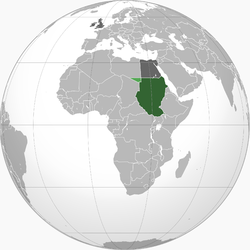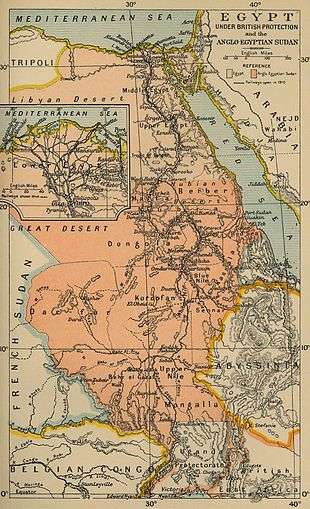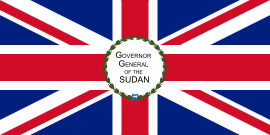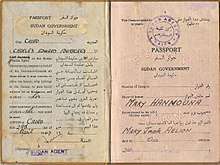Anglo-Egyptian Sudan
| Anglo-Egyptian Sudan السودان اﻹنجليزي المصري | |||||||||
|---|---|---|---|---|---|---|---|---|---|
| 1899–1956 | |||||||||
 | |||||||||
|
Anthem: God Save the King/Queen | |||||||||
 Green: Anglo-Egyptian Sudan Light green: Ceded to Italian Libya in 1934 Dark grey: Egypt and the United Kingdom | |||||||||
| Status | Condominium of the United Kingdom and Kingdom of Egypt | ||||||||
| Capital | Khartoum | ||||||||
| Common languages |
English (official) Nubian Beja Nuer Dinka Fur Shilluk Arabic | ||||||||
| Religion |
Christianity Animism Sunni Islam | ||||||||
| Historical era | British Imperial | ||||||||
• Established | 19 June 1899 | ||||||||
• Self-rule | 22 October 1952 | ||||||||
• Independence | 1 January 1956 | ||||||||
| Area | |||||||||
| 1951[1] | 2,505,800 km2 (967,500 sq mi) | ||||||||
| Population | |||||||||
• 1951[2] | 8,079,800 | ||||||||
| Currency | Egyptian pound/gineih | ||||||||
| |||||||||
| Today part of |
| ||||||||
The Anglo-Egyptian Sudan (Arabic: السودان الإنجليزي المصري as-Sūdān al-Inglīzī al-Maṣrī) was a condominium of the United Kingdom and Egypt in the eastern Sudan region of northern Africa between 1899 and 1956, but in practice the structure of the condominium ensured full British control over the Sudan with Egypt having local influence instead. It attained independence as the Republic of the Sudan, which since 2011 has been split into Sudan and South Sudan.
Until 1814, Egypt itself was nominally part of the Ottoman Empire. During the 19th century it gradually expanded its control of the Sudan as far south as the Great Lakes region. In 1881 the Mahdist revolt broke out in Sudan and in 1882 the British invaded Egypt. Egypt became a de facto protectorate of Britain and together British and Egyptian forces gradually re-conquered the Sudan. In 1899, they formally agreed to establish a joint protectorate: Egypt on the basis of its previous claims and Britain by right of conquest.
Between 1914 and 1922, Egypt and thus the Sudan were formally a part of the British Empire. After Egyptian independence in 1922, Britain gradually assumed more control of the condominium, edging out Egypt almost completely by 1924. Increasing Egyptian dissatisfaction with this arrangement came to a head after the overthrow of the Egyptian monarch in 1952. On 1 January 1956, Egypt and Britain ceded Sudan its independence.
Background
Union with Egypt
In 1820, the army of Egyptian wāli Muhammad Ali Pasha, commanded by his son Ismail Pasha,[3] gained control of Sudan. The region had longstanding linguistic, cultural, religious, and economic ties to Egypt and had been partially under the same government at intermittent periods since the times of the pharaohs. Muhammad Ali was aggressively pursuing a policy of expanding his power with a view to possibly supplanting the Ottoman Empire (to which he technically owed fealty) and saw Sudan as a valuable addition to his Egyptian dominions. During his reign and that of his successors, Egypt and Sudan came to be administered as one political entity, with all ruling members of the Muhammad Ali dynasty seeking to preserve and extend the "unity of the Nile Valley". This policy was expanded and intensified most notably by Muhammad Ali's grandson, Ismail Pasha, under whose reign most of the remainder of modern-day Sudan was conquered.
British involvement

With the opening of the Suez Canal in 1869, Egypt and Sudan's economic and strategic importance increased enormously, attracting the imperial attentions of the Great Powers, particularly the United Kingdom. Ten years later in 1879, the immense foreign debt of Ismail Pasha's government served as the pretext for the Great Powers to force his abdication and replacement by his son Tewfik Pasha. The manner of Tewfik's ascension at the hands of foreign powers greatly angered Egyptian and Sudanese nationalists who resented the ever-increasing influence of European governments and merchants in the affairs of the country. The situation was compounded by Tewfik's perceived corruption and mismanagement and ultimately culminated in the 'Urabi Revolt. With the survival of his throne in dire jeopardy, Tewfik appealed for British assistance. In 1882, at Tewfik's invitation, the British bombarded Alexandria, Egypt's and Sudan's primary seaport, and subsequently invaded the country. British forces overthrew the Urabi government in Cairo and proceeded to occupy the rest of Egypt and Sudan in 1882. Though officially the authority of Tewfik had been restored, in reality the British largely took control of Egyptian and Sudanese affairs until 1932.[3]
Mahdist revolt
Tewfik's acquiescence to British occupation as the price for securing the monarchy was deeply detested by many throughout Egypt and Sudan. With the bulk of British forces stationed in northern Egypt, protecting Cairo, Alexandria, and the Suez Canal, opposition to Tewfik and his European protectors was stymied in Egypt. In contrast, the British military presence in Sudan was comparatively limited and eventually revolt broke out. The rebellion in Sudan, led by the Sudanese religious leader Muhammad ibn Abdalla, the self-proclaimed Mahdi (Guided One), was both political and religious. Abdalla wished not only to expel the British, but to overthrow the monarchy, viewed as secular and Western-leaning, and replace it with a pure Islamic government. Whilst primarily a Sudanese figure, Abdalla even attracted the support of some Egyptian nationalists and caught Tewfik and the British off-guard. The revolt culminated in the fall of Khartoum and the death of the British General Charles George Gordon (Gordon of Khartoum) in 1885. Tewfik's forces and those of the United Kingdom were forced to withdraw from almost all of Sudan with Abdalla establishing a theocratic state.
Abdalla's religious government imposed traditional Islamic laws upon Sudan and stressed the need to continue the armed struggle until the British had been completely expelled from the country and all of Egypt and Sudan was under his Mahdiya. Though he died six months after the fall of Khartoum, Abdalla's call was fully echoed by his successor, Abdallahi ibn Muhammad, who invaded Ethiopia in 1887 and penetrated as far as Gondar, and the remainder of northern Sudan and Egypt in 1889. This invasion was halted by Tewfik's forces, and was followed later by withdrawal from Ethiopia. Abdullahi wrecked virtually all of the previous Turkish and Fung administrative systems and gravely weakened Sudanese tribal unities. From 1885 to 1898 the population of Sudan collapsed from eight to three million due to war, famine, disease and persecution.[3]
Anglo-Egyptian condominium (1899–1956)

After a series of Mahdist defeats, Tewfik's son and successor, Abbas II, and the British decided to re-establish control over Sudan. Leading a joint Egyptian-British force, Kitchener led military campaigns from 1896 to 1898. Kitchener's campaigns culminated in the Battle of Atbara and the Battle of Omdurman.[3] Exercising the leverage which their military superiority provided, the British forced Abbas to accept British control in Sudan. Whereas British influence in Egypt was officially advisory (though in reality it was far more direct), the British insisted that their role in Sudan be formalised. Thus, an agreement was reached in 1899 establishing Anglo-Egyptian rule (a condominium), under which Sudan was to be administered by a governor-general appointed by Egypt with British consent. In reality, much to the revulsion of Egyptian and Sudanese nationalists, Sudan was effectively administered as a British imperial possession. Pursuing a policy of divide and rule, the British were keen to reverse the process, started under Muhammad Ali, of uniting the Nile Valley under Egyptian leadership, and sought to frustrate all efforts to further unite the two countries. During World War I, the British invaded and incorporated Darfur into the Anglo-Egyptian Sudan in 1916.
This policy was internalised within Sudan itself, with the British determined to exacerbate differences and frictions between Sudan's numerous different ethnic groups. From 1924 onwards, the British essentially divided Sudan into two separate territories–a predominantly Muslim Arabic-speaking north, and a predominantly Animist and Christian south, where the use of English was encouraged by Christian missionaries, whose main role was instructional.
The continued British occupation of Sudan fuelled an increasingly strident nationalist backlash in Egypt, with Egyptian nationalist leaders determined to force Britain to recognise a single independent union of Egypt and Sudan. With the formal end in 1914 of the legal fiction of Ottoman sovereignty, Hussein Kamel was declared Sultan of Egypt and Sudan, as was his brother Fuad I who succeeded him. The insistence of a single Egyptian-Sudanese state persisted when the Sultanate was re-titled the Kingdom of Egypt and Sudan, but the British continued to frustrate these efforts.
The failure of the government in Cairo to end the British occupation led to separate efforts for independence in Sudan itself, the first of which was led by a group of Sudanese military officers known as the White Flag League in 1924. The group was led by first lieutenant Ali Abd al Latif and first lieutenant Abdul Fadil Almaz. The latter led an insurrection of the military training academy, which ended in their defeat and the death of Almaz after the British army blew up the military hospital where he was garrisoned. This defeat was (allegedly) partially the result of the Egyptian garrison in Khartoum North not supporting the insurrection with artillery as was previously promised.
Abrogation of the condominium
Even when the British ended their occupation of Egypt in 1936 (with the exception of the Suez Canal Zone), they maintained their forces in Sudan. Successive governments in Cairo, repeatedly declaring their abrogation of the condominium agreement, declared the British presence in Sudan to be illegitimate, and insisted on full British recognition of King Farouk as "King of Egypt and Sudan", a recognition which the British were loath to grant; not least because Farouk was secretly negotiating with Mussolini for an Italian invasion. The defeat of this damaging démarche of 1940 for Anglo-Egyptian relations helped to turn the tide of the Second World War.

It was the Egyptian Revolution of 1952 which finally set a series of events in motion which would eventually end the British and Egyptian occupation of Sudan. Having abolished the monarchy in 1953, Egypt's new leaders, Muhammad Naguib, who was raised as a child of an Egyptian army officer in Sudan, and Gamal Abdel Nasser, believed the only way to end British domination in Sudan was for Egypt itself to officially abandon its sovereignty over Sudan. Since the British claim to control in Sudan theoretically depended upon Egyptian sovereignty, the revolutionaries calculated that this tactic would leave the UK with no option but to withdraw. In addition Nasser knew that it would be problematic for Egypt to govern the impoverished Sudan. In October 1954, the governments of Egypt and the UK signed a treaty guaranteeing Sudanese independence. On 1 January 1956, the date agreed between the Egyptian and British governments, Sudan became an independent sovereign state, ending its nearly 136-year union with Egypt and its 56-year occupation by the British.
Governors
Chief Justices
- 1903–1917 Wasey Sterry[4] (until 1915 Chief Judge)
- 1917–1926 Robert Hay Dun[5]
- 1926–1930 Sir Bernard Humphrey Bell[6]
- 1930?–1936? Howell Owen
- 1936–1941 Thomas Percival Creed
- 1941–1944 Sir Hubert Flaxman
- 1944–1946 Cecil Harry Andrew Bennett
- 1946–1947 Sir Charles Cecil George Cumings
- 1947–1950 Thomas Arthur Maclagan[7]
- 1950–1955 William O'Brien Lindsay[8]
- 1955–1964 Mohamed Ahmed Abu Rannat
See also
References
- ↑ "Sudan Almanac 1951," Public Relations Department of the Sudan Government, McCorquedale & Co. Ltd., Khartoum, 1951, page 52.
- ↑ "Sudan Almanac 1951," Public Relations Department of the Sudan Government, McCorquedale & Co. Ltd., Khartoum, 1951, page 52.
- 1 2 3 4 Henderson, K.D.D. "Survey of the Anglo-Egyptian Sudan 1898–1944", Longmans, Green and Co. Ltd., London, 1946
- ↑ Daly, m. Empire on the Nile: The Anglo-Egyptian Sudan, 1898-1934. p. 153.
- ↑ Collins, Robert. An Arabian Diary. p. 317.
- ↑ "Bell, Sir Bernard Humphrey (1884-1959), colonial judge and Chief Justice of Sudan 1926-1930". National Archives. Retrieved 1 March 2016.
- ↑ Sudan Almanac 1949. Khartoum, Sudan: The Sudan Government, Khartoum, Sudan. 1949. p. 48.
- ↑ Sudan Almanac 1952. Khartoum, Sudan: Public Relations Office, Sudan Government, Khartoum. 1951. p. 48.
Coordinates: 15°37′59″N 32°31′59″E / 15.63306°N 32.53306°E